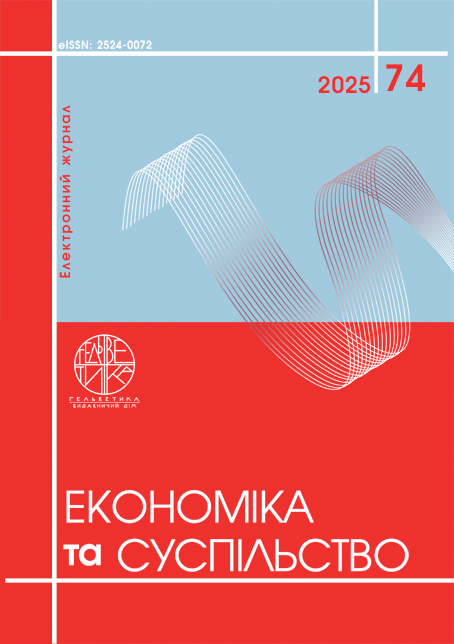RATIONALITY OF RISK MANAGEMENT IN ENERGY ENTERPRISES IN THE CONTEXT OF CIRCULAR ECONOMY VALUES
Abstract
The article reveals the essence and substantiates the practical significance of rational risk management in the energy sector within the framework of the circular economy paradigm. Emphasis is placed on the transformation of risk management from a traditional functional activity into a strategic tool for enhancing resilience, energy efficiency, and environmental responsibility of energy enterprises. It is established that under the influence of global climate, geopolitical, and infrastructure risks, as well as the growing digitalization of production and operational processes, classical approaches to risk management are losing their effectiveness. Instead, integrated models based on closed-loop resource use, eco-innovation, predictive analytics, and managerial flexibility are gaining increasing relevance. The dynamics of implementing circular approaches to risk management in Ukrainian energy enterprises during 2014–2024 are analyzed. Statistical and analytical data are provided regarding the growth of renewable energy share, modernization of energy-generating facilities, implementation of digital technologies (SCADA systems, digital twins, IoT), and the development of early warning and forecasting systems. It is shown that enterprises applying circular solutions (resource recycling, reuse of technical water, utilization of by-products) demonstrate significant reductions in operational costs, CO₂ emissions, and accident rates, along with increased supply stability. A direct correlation is identified between the integration of ESG principles into company strategies and increased investment attractiveness and capitalization. It is concluded that the circular economy not only reshapes the context of risk management but also creates a new system of managerial values focused on long-term resilience, balanced resource use, and ecological safety. Rational risk management in such a system is based on the integration of quantitative analysis, digital monitoring, forecasting, and preventive strategies, transforming risks from threats into sources of strategic advantage. The findings are of interest to professionals in the fields of energy, environmental management, digital transformation, and sustainable development.
References
Fischhoff, B., Watson, S., & Hope, C. (1984). Defining risk. Policy Sciences, 17, 123-139. https://doi.org/10.1007/BF00146924 .
Jacobs, L. (2000). An analysis of the concept of risk. Cancer nursing, 23 1, 12-9 . https://doi.org/10.1097/00002820-200002000-00003 .
Aven, T., & Renn, O. (2009). On risk defined as an event where the outcome is uncertain. Journal of Risk Research, 12, 1 - 11. https://doi.org/10.1080/13669870802488883 .
Holton, G. (2004). Defining Risk. Financial Analysts Journal, 60, 19 - 25. https://doi.org/10.2469/faj.v60.n6.2669 .
Slovic, P., & Peters, E. (2006). Risk Perception and Affect. Current Directions in Psychological Science, 15, 322 - 325. https://doi.org/10.1111/j.1467-8721.2006.00461.x .
Isaacs, D. (2020). Risk. Journal of Paediatrics and Child Health, 56. https://doi.org/10.1111/jpc.14665 .
Jardine, C., & Hrudey, S. (1999). What is Risk. 205-211. https://doi.org/10.1007/978-94-011-4740-8_17 .
Kaplan, S., & Garrick, B. (1981). On The Quantitative Definition of Risk. Risk Analysis, 1, 11-27. https://doi.org/10.1111/J.1539-6924.1981.TB01350.X.
Drucker, P. (2018). The Essential Drucker. https://doi.org/10.4324/9780080939322.
Webster, F. (2009). Marketing IS management: The wisdom of Peter Drucker. Journal of the Academy of Marketing Science, 37, 20-27. https://doi.org/10.1007/S11747-008-0102-4 .
Hammond, G., & Waldron, R. (2008). Risk assessment of UK electricity supply in a rapidly evolving energy sector. Proceedings of the Institution of Mechanical Engineers, Part A: Journal of Power and Energy, 222, 623 - 642. https://doi.org/10.1243/09576509JPE543 .
Gitelman, L., Gitelman, L., & Kozhevnikov, M. (2017). A methodological framework for organizational risk management in energy companies. International Journal of Safety and Security Engineering, 7, 41-51. https://doi.org/10.2495/SAFE-V7-N1-41-51 .
Fischhoff, B., Watson, S., & Hope, C. (1984). Defining risk. Policy Sciences, 17, 123-139. https://doi.org/10.1007/BF00146924 .
Jacobs, L. (2000). An analysis of the concept of risk. Cancer nursing, 23 1, 12-9 . https://doi.org/10.1097/00002820-200002000-00003 .
Aven, T., & Renn, O. (2009). On risk defined as an event where the outcome is uncertain. Journal of Risk Research, 12, 1 - 11. https://doi.org/10.1080/13669870802488883 .
Holton, G. (2004). Defining Risk. Financial Analysts Journal, 60, 19 - 25. https://doi.org/10.2469/faj.v60.n6.2669 .
Slovic, P., & Peters, E. (2006). Risk Perception and Affect. Current Directions in Psychological Science, 15, 322 - 325. https://doi.org/10.1111/j.1467-8721.2006.00461.x .
Isaacs, D. (2020). Risk. Journal of Paediatrics and Child Health, 56. https://doi.org/10.1111/jpc.14665 .
Jardine, C., & Hrudey, S. (1999). What is Risk. 205-211. https://doi.org/10.1007/978-94-011-4740-8_17 .
Kaplan, S., & Garrick, B. (1981). On The Quantitative Definition of Risk. Risk Analysis, 1, 11-27. https://doi.org/10.1111/J.1539-6924.1981.TB01350.X.
Drucker, P. (2018). The Essential Drucker. https://doi.org/10.4324/9780080939322.
Webster, F. (2009). Marketing IS management: The wisdom of Peter Drucker. Journal of the Academy of Marketing Science, 37, 20-27. https://doi.org/10.1007/S11747-008-0102-4 .
Hammond, G., & Waldron, R. (2008). Risk assessment of UK electricity supply in a rapidly evolving energy sector. Proceedings of the Institution of Mechanical Engineers, Part A: Journal of Power and Energy, 222, 623 - 642. https://doi.org/10.1243/09576509JPE543 .
Gitelman, L., Gitelman, L., & Kozhevnikov, M. (2017). A methodological framework for organizational risk management in energy companies. International Journal of Safety and Security Engineering, 7, 41-51. https://doi.org/10.2495/SAFE-V7-N1-41-51 .

This work is licensed under a Creative Commons Attribution 4.0 International License.


